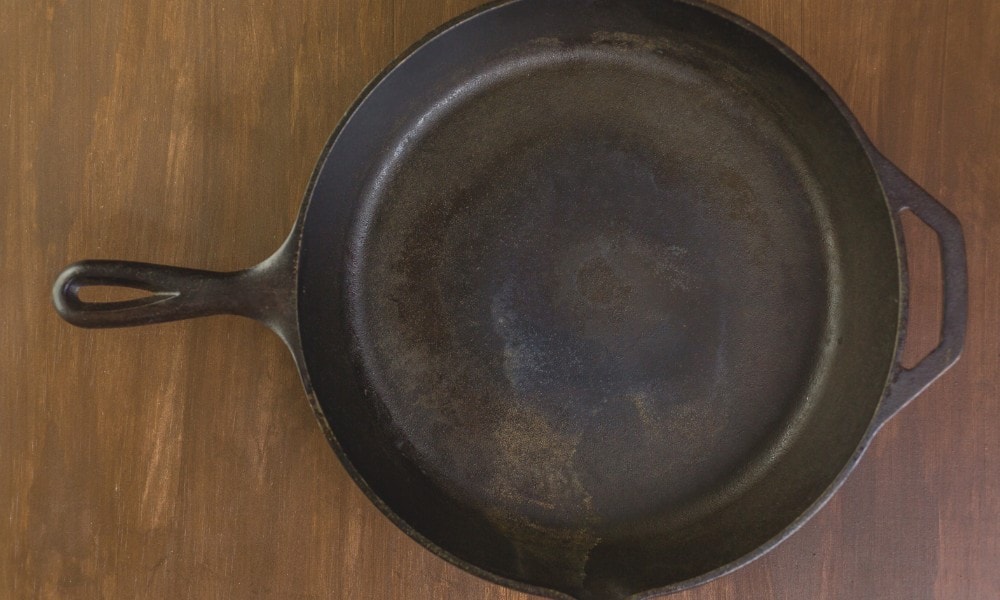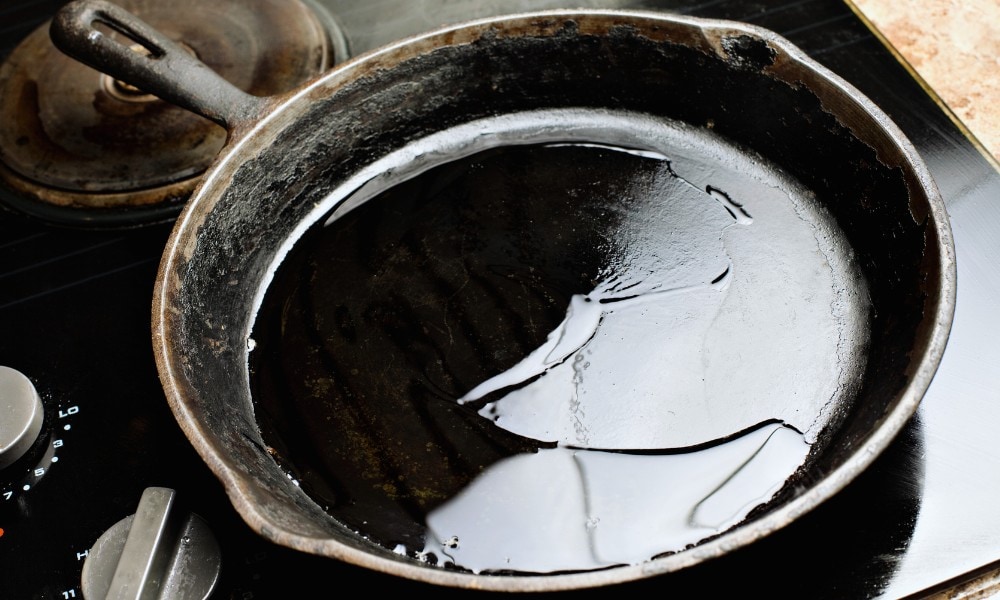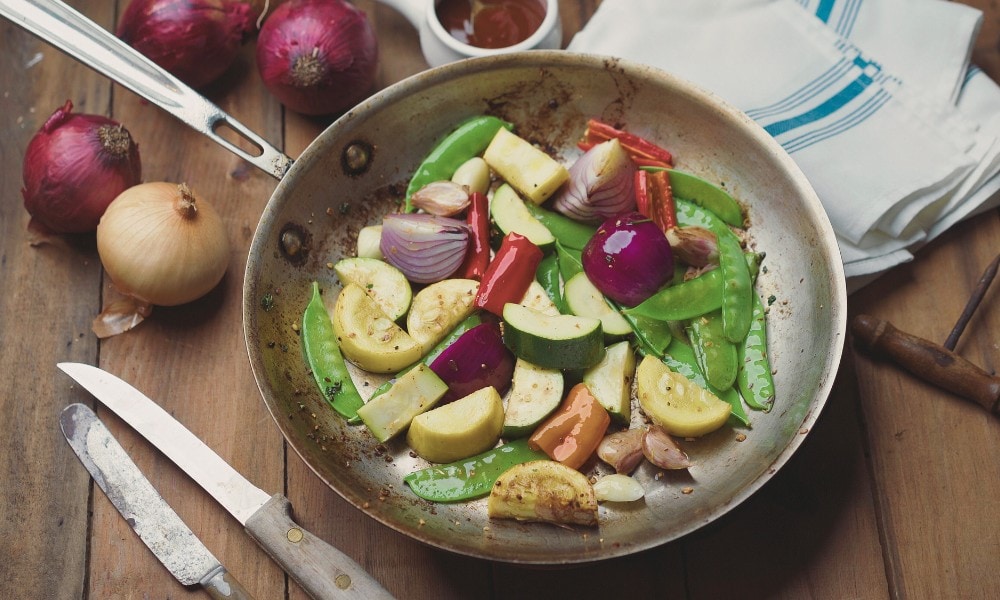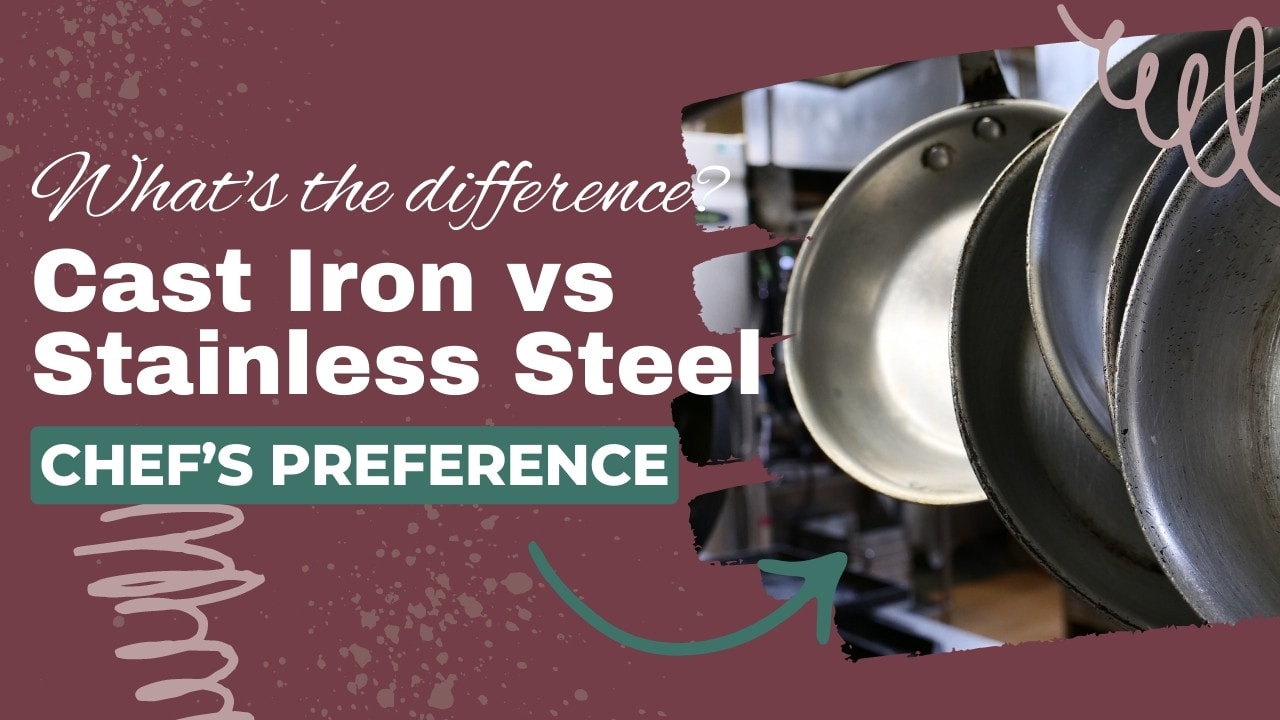You’re treating yourself to a new piece of cookware. You’re at the shops, confronted with the cookware section, and you ask: cast iron vs. stainless steel cookware- what is the difference?
Well, the material you cook on is much more than a matter of price or aesthetic preference. The choice to use stainless steel or cast iron will not only affect the texture and flavor of your food, but can impact its nutritional value as well!
In this article, we’ll discuss:
- Differences between cast iron and stainless steel.
- Performance: which cooking tasks each is best suited for.
- Cost differences.
- Health concerns relating to these materials.
Cast Iron vs. Stainless Steel Cookware
Cast iron and stainless steel are two time-tested cookware materials – but they’re best suited for different purposes. While both can be used for searing, cast iron is best for slow cooking and use on the grill, while stainless steel is suitable for everyday use like sauteing, frying, poaching, and caramelizing. Cast iron will react with acidic foods, so stainless steel needs to be used for dishes that involve tomatoes or vinegar.
There’s a learning curve to using both cast iron and stainless steel, but most home cooks will get more use out of a stainless steel pan due to its lighter weight and versatility.
Features of Cast Iron Pans
- Made of iron-carbon alloy. Black in color.
- Heavy and more brittle than steel.
- A 10” cast iron skillet weighs 4.6 pounds, about a whole pound more than a stainless skillet of the same size.
- Needs seasoning with oil and heat after every use to remain non-stick.
- Imparts flavor and iron mineral to food.
- Reacts with acidic food.
- Takes longer to heat up and can develop heat spots.
- Regarded as safer than Teflon or chemical-coated pans.
- Wonderful for grilling, searing, baking, or cooking pancakes.

Features of Stainless Steel Pans
- Stainless steel is a steel alloy that can be made of multiple different metals, including iron, chromium, and nickel.
- Nickel provides a shiny silver finish on stainless steel pans.
- Stainless pans may be layered with aluminum or copper cores for better heat conductivity.
- Stainless steel pans heat evenly and are great all-around pans suitable for frying, sauteing, or making sauces.
- Lighter in weight than cast iron. A 10” stainless skillet weighs an average of 3.5 pounds.
- Can be seasoned but doesn’t develop a dark patina like cast iron.
- Can be non-stick if used properly, but there’s a learning curve.
- Generally regarded as non-toxic.

How Do Cast Iron and Stainless Steel Compare?
The cast iron vs. stainless steel cheat sheet above and the details described below can help you decide which cookware is best for spending your hard-earned money on!
Heating
When I’m looking at cookware, I first consider how easily it heats up and how even its heat distribution is.
In general, cast iron pans take significantly longer to heat than stainless steel pans, because they are made of heavier, denser material.
Stainless steel is actually a poor conductor of heat on its own, but three or five-ply stainless steel pans are layered with aluminum or have copper bottoms, which aid in heat distribution.
Professional chef Anthony Vitolo points out that cast iron can develop heat spots, which can lead to uneven cooking, while stainless steel heats evenly across the whole pan. This factor is critical, especially when cooking proteins like steak, where you want the heat to be as even as possible.
The only way to get around the heat spots in cast iron is to preheat it in a hot oven. This will heat the whole pan slowly to an even heat across the whole pan before you add the ingredients. However, this adds an extra step that a lot of us would rather skip when we’re just trying to get dinner on the table.
Ease of Use
I find that stainless steel is more effortless to cook with when compared to cast iron. A properly cared for stainless pan just requires a preheat on the stove before adding oil and ingredients.
Cast iron, however, must be inspected for rust, cleaned, and thoroughly preheated (preferably in the oven) for it to be ready. If the seasoning is worn off, you should also re-season it before cooking.

What happens if you don’t? Well, for instance, if you are cooking steak and the cast iron isn’t preheated or seasoned well enough, the meat will stick in some places and caramelize well in other areas.
A hot stainless steel pan, on the other hand, will achieve an even crust across the whole steak as long as the pan is heated before applying oil and ingredients.
When it comes to cooking, stainless steel is very light and easy to handle. Tossing vegetables can be done with one hand. But cast iron is the opposite. Cast iron pans weigh about 5-10 pounds, while stainless steel weighs around 2-6 pounds. This extra weight makes the cast iron hard to maneuver, which is why I prefer it for searing and slow-cooking stews where there is little movement involved.
Maintenance
Another significant downside that is hard to ignore is the maintenance required for cast iron.
Cast iron requires a special first-time cleaning and seasoning, and then regular seasoning in order to maintain its non-stick and rust-resistant qualities.
What does it mean to “season” a pan? Seasoning a pan involves baking layers of oil into the pan’s surface. You do this by simply rubbing a layer of oil all around the interior of the pan and rubbing it in, while the pan is hot.

To prevent the seasoning from being damaged, I suggest storing cast iron with a layer of paper towel on the surface. This is a whole step that you get to skip if you go with a stainless steel pan.
Cleaning
Cleaning cookware is everyone’s least favorite job, so this is an important factor to consider when buying it.
Stainless steel is usually easy to clean. You can pop it in the dishwasher or wash it in hot soapy water with a soft sponge. Then it can be safely left to air dry after cleaning.
The only thing that gets tricky about cleaning stainless steel is that if you don’t apply enough oil or apply it at the right time in cooking, food will stick to stainless steel and be difficult to wash off.
Cast iron is overall more complicated. Washing cast iron in soapy water will remove the seasoning from the pan, so you will have to start from scratch. Instead, you should clean the cast iron out with a damp rag.
If any stubborn pieces are sticking, then I use a salt and oil mix to scrub them off. Once you’ve cleaned the pans, they must be thoroughly dried out before storing them to avoid rust. Re-season the pan between each use to maintain the surface.
Durability and Reliability
If you want a pan that’s going to last you forever, cast iron is the one to choose. I have seen so many cast iron pans being handed down from generation to generation because they are so hardy and well-made. Since they are cast all in one piece, you won’t have to deal with loose rivets. (But this also means that the handle will get very hot, so I advise wearing an oven glove when handling your pan!)
I don’t know about you, but I’ve had more than one stainless steel pan with handles that get wobbly over time and require tightening. Stainless steel is also more subject to dents, scratches, and stainings. That said, if you invest in a high-quality set of stainless steel cookware, it can also last for generations with proper maintenance.
Versatility
My favorite thing about both these materials is the fact that they are oven safe. If you are cooking a dish that requires stovetop-to-oven use, like searing a steak and finishing it in the oven, you can take the pan straight off the stove and place it into the oven. The pan will produce even heat around the dish and cook it all the way through without burning the bottom.
But before you put your stainless steel pan in the oven, make sure they don’t have plastic handles that can melt!
Stainless steel cookware can essentially be used for anything. Searing, frying, stewing, boiling, making sauces – it can handle it all!

Cast iron, however, is a bit more finicky. While I find it useful for searing, stewing, and boiling, I avoid using cast iron to fry. Being exposed to very hot vegetable oil will cause a reaction with iron, which produces trans fats. You also need to avoid cooking acidic foods in cast iron, as this can also cause a reaction that will discolor your dish and deposit a metallic flavor into the dish.
One time I prefer cast iron over stainless steel is when I’m grilling, which you can’t do with stainless steel. If I’m grilling but have a dry-aged steak I want to cook, I like to pop that in a cast iron skillet that has been well-preheated on the fire beforehand. This will help preserve the flavor of the dry-aged steak without having to run between the stovetop inside and the grill outside to cook your different meats.
But, overall, I find stainless steel cookware far more versatile than cast iron.
Health Concerns
You may have noticed people online voicing their concerns about metals like nickel and chromium leaching into foods from stainless steel cookware. But Dr. Greger at NutritionFacts.org assures us in the video linked below that this leaching only happens when the pans are brand new and will cease after the sixth use. Even then, the quantities are small.
Cast iron is made of iron with 2% or more carbon. While cooking, small amounts of iron will be deposited into the food through the pan; this happens especially with acidic foods. Unless your iron levels are already elevated, this amount of iron is not typically dangerous to consume and may actually be helpful to those who are iron deficient.
Price and Grade
How much cookware costs is a huge factor when making a buying decision. But before we jump into comparing prices, consider how often you will use a pan when looking at these numbers.
When compared purely by price, cast iron is cheaper than stainless steel. And there’s relatively little price difference between different brands of iron pans. Since they’re all essentially a single piece of iron alloy, apart from some brand recognition, there aren’t a lot of features to cause price variance.
Stainless steel has a more extensive price range. A 10” stainless steel skillet will range from the same price as a cast iron one to three times that amount. The price difference is based on factors such as the quality of stainless steel used, construction and design features, brand reputation, manufacturing processes, and country of manufacture.
Higher-grade stainless steel with better corrosion resistance and durability, such as five-ply 18/10 stainless steel, is more expensive than two-ply, three-ply or lower-grade alternatives.
- 2-ply stainless steel pans have a two-layer construction, typically with a stainless steel top and aluminum or copper bottom.
- 3-ply stainless steel pans have three layers: a stainless steel interior, an aluminum or copper core layer for enhanced heat conductivity, and a stainless steel exterior.
- 5-ply stainless steel pans consist of five layers: stainless steel at the top, center, and bottom with two layers of aluminum sandwiched in between.
What does 18/10 stainless steel mean? The numbers in stainless steel grades like 18/10, 18/8, and 18/0 represent the percentages of chromium and nickel in the alloy. 18/10 stainless steel has a higher nickel content, making it more resistant to corrosion and giving it a brighter appearance. It is often considered the highest grade of stainless steel cookware.
So now we can circle back to the cost per use that I mentioned at the beginning. While the initial cost of cast iron might be lower, the amount you use a stainless steel pan will quickly make it a better value for money because it’s so versatile. My advice is to save up a little longer to buy a good quality three or five-ply stainless steel pan because you can use it for almost everything in comparison with cast iron.

Conclusion
At the end of the day, whether or not you buy cast iron or stainless steel ultimately comes down to the use you want it to serve. Want to sear a steak to perfection or make classic hotcakes? Cast iron is your guy. If you want to quickly fry up something for dinner, then stainless steel is ideal. I love having both of these timeless pans on hand. But if you made me choose between the two, I would go for a stainless steel pan because they are so versatile and have great heat distribution while being easy to handle.









